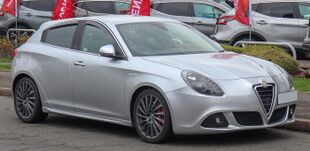Engineering:Fiat Compact platform
| Fiat Compact platform | |
|---|---|
 | |
| Overview | |
| Manufacturer | Alfa Romeo (FCA Italy) Chrysler Group LLC (2012–2014) FCA US LLC (2014–2021) Stellantis North America (2021–present) |
| Also called | Short wheelbase: Compact Long wheelbase: Compact-Wide |
| Production | 2010–present |
| Body and chassis | |
| Class | Compact car platform |
| Layout | Transverse Front-engine, front-wheel drive / four-wheel drive |
| Powertrain | |
| Engine(s) | 1.4L FIRE Turbo I4 Gasoline 1.4L FIRE Turbo I4 Gasoline/CNG 1.4L Multiair Turbo I4 Gasoline 1.75 L DI Turbo I4 Gasoline 2.0L Tigershark I4 Gasoline 2.4L Tigershark Multiair I4 Gasoline 3.2L Pentastar V6 Gasoline 3.6L Pentastar V6 Gasoline 1.6L Multijet I4 diesel 2.0L Multijet I4 diesel |
| Chronology | |
| Predecessor | Fiat C-platform Chrysler GS platform Chrysler RT platform |
| Successor | STLA Medium platform (C-Segment) |
The Compact platform was developed by engineers of the Fiat group for the construction of small family cars (compact cars) and large family cars (mid-size cars) with front-wheel drive or four-wheel drive. The first incarnation of this platform was the Alfa Romeo Giulietta which was unveiled in 2010.[1] Fiat has invested 100 million euros into the construction of the Compact Platform. [2]
Origin
Developed in Turin, Italy, the Compact platform was designed to adapt to future cars of both the Fiat and Chrysler group. Developed a new high-performance platform that uses only a front central part of the floor from the old C-platform. The frame composition is 84% high-strength steel (as opposed to the old C-platform, 65% of which was high-strength steel) and 4% aluminum, and magnesium. The front suspension uses MacPherson Evo struts with aluminum uprights and is 4 kilograms (8.8 lb) lighter than the previous design with steel uprights (as used in the Fiat Bravo). The rear suspension uses an independent multi-link suspension and each of them consists of two lateral links with an aluminum longitudinal arm that mounts the hub and spring.[3] Using aluminium rather than steel, which has a higher density, enabled a total combined weight-savings in the suspension bits of 14 kilograms. The framework for the rear seats and the magnesium alloy cross member reduced weight by 35% in comparison to earlier cars.[4]
The platform offers a compact transverse engine at the front with either front or four-wheel drive. The total platform weight of the standard version (on the compact models) is 174 kilograms (384 lb).
Long wheelbase version (Compact Wide)
The long wheelbase version is called Compact Wide and was used for US-built models of Chrysler sedans like the Dodge Dart and Chrysler 200. The CUSW products first appeared in late 2011.[5] The interchangeable modules make the basic platform suitable for vehicles of differing lengths up to 4.92 metres (16.1 ft). It was designed with additional features for a compact platform that could adapt to sports cars like Alfa Romeo.
The engine range, combined with the platform, consists of the compact four-cylinder petrol 1.4 Fire, 1.4 Multiair, 1.75 TBi turbocharged, the 2.0 or 2.4 Chrysler GEMA engine, the 3.2 or the 3.6 Chrysler Pentastar V6 engine, and the 1.6, 2.0 and 2.2 Multijet turbodiesel engines. Fiat and Chrysler planned to build about 1 million vehicles a year by 2014 based on this platform. Eight upcoming Chrysler Group vehicles are planned to be built on Fiat's Compact Wide platform, including the replacement for the Jeep Liberty.[6]
Vehicles based on Fiat Compact platform
- Compact:
- 2010–2020 Alfa Romeo Giulietta
- Compact Wide:
- 2012–2017 Dodge Dart/Fiat Viaggio/Ottimo[7]
- Compact Wide LWB:
- 2014–2017 Chrysler 200
- 2017–present Chrysler Pacifica
- 2020–present Chrysler Voyager
- Compact Wide LWB 4X4:
- 2014–2023 Jeep Cherokee
- 2018–2022 Jeep Grand Commander
References
- ↑ "New Fiat platform will underpin 1M models a year". autonews.com. http://europe.autonews.com/article/20100215/ANE/100219943/new-fiat-platform-will-underpin-1m-models-a-year. Retrieved 28 September 2011.
- ↑ re (14 June 2009). "Development of new platform". Italiaspeed.com. http://www.italiaspeed.com/2009/cars/industry/06/chrysler/1306_new_models.html. Retrieved 28 September 2011.
- ↑ "Alfa Romeo Giulietta TUTTE LE SOLUZIONI TECNICHE" (in it). Quattroruote.it. Archived from the original on 29 March 2012. https://web.archive.org/web/20120329060849/http://www.quattroruote.it/notizie/auto-novita/tutte-le-soluzioni-tecniche-alfa-romeo-giulietta. Retrieved 28 September 2011.
- ↑ "Overview: Fiat Group’s ‘Compact’ platform". under-the-skin.org.uk. http://under-the-skin.org.uk/news_alfacompact.html. Retrieved 28 September 2011.
- ↑ "Dodge will get first Fiat-based car in late 2011, Marchionne says". autonews.com. http://www.autonews.com/apps/pbcs.dll/article?AID=/20101021/OEM01/101029967/1251. Retrieved 28 September 2011.
- ↑ "Chrysler CEO: Dart certification will yield final 5% stock award". autonews.com. http://www.autonews.com/apps/pbcs.dll/article?AID=/20111207/OEM/111209911/1251. Retrieved 8 December 2011.
- ↑ "Dodge Hits the Mark With the All-new 2013 Dodge Dart Compact Car". media.chrysler.com. http://www.media.chrysler.com/newsrelease.do;jsessionid=82E1B1F118AF0F98598F5E42B9A8E192?&id=11816&mid=2. Retrieved 7 December 2011.
 |








